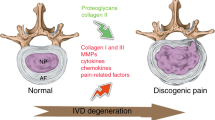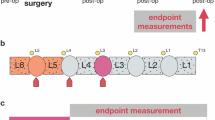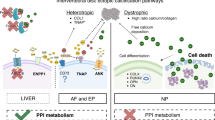Abstract
Purpose
Chronic low back pain causes structural remodelling and inflammation in the multifidus muscle. Collagen expression is increased in the multifidus of humans with lumbar disc degeneration. However, the extent and mechanisms underlying the increased fibrotic activity in the multifidus are unknown. Physical activity reduces local inflammation that precedes multifidus fibrosis during intervertebral disc degeneration (IDD), but its effect on amelioration of fibrosis is unknown. This study aimed to assess the development of fibrosis and its underlying genetic network during IDD and the impact of physical activity.
Methods
Wild-type and SPARC-null mice were either sedentary or housed with a running wheel, to allow voluntary physical activity. At 12 months of age, IDD was assessed with MRI, and multifidus muscle samples were harvested from L2 to L6. In SPARC-null mice, the L1/2 and L3/4 discs had low and high levels of IDD, respectively. Thus, multifidus samples from L2 and L4 were allocated to low- and high-IDD groups compared to assess the effects of IDD and physical activity on connective tissue and fibrotic genes.
Results
High IDD was associated with greater connective tissue thickness and dysregulation of collagen-III, fibronectin, CTGF, substance P, TIMP1 and TIMP2 in the multifidus muscle. Physical activity attenuated the IDD-dependent increased connective tissue thickness and reduced the expression of collagen-I, fibronectin, CTGF, substance P, MMP2 and TIMP2 in SPARC-null animals and wild-type mice. Collagen-III and TIMP1 were only reduced in wild-type animals.
Conclusions
These data reveal the fibrotic networks that promote fibrosis in the multifidus muscle during chronic IDD. Furthermore, physical activity is shown to reduce fibrosis and regulate the fibrotic gene network.
Graphical abstract
These slides can be retrieved under Electronic Supplementary Material.







Similar content being viewed by others
References
Hoy D, March L, Brooks P et al (2014) The global burden of low back pain: estimates from the Global Burden of Disease 2010 study. Ann Rheum Dis 73:968–974
Hodges PW, James G, Blomster L et al (2015) Multifidus muscle changes after back injury are characterized by structural remodeling of muscle, adipose and connective tissue, but not muscle atrophy: molecular and morphological evidence. Spine 40:1057–1071
Klyne DM, Barbe MF, Hodges PW (2017) Systemic inflammatory profiles and their relationships with demographic, behavioural and clinical features in acute low back pain. Brain Behav Immun 60:84–92
Klyne DM, Barbe MF, van den Hoorn W et al (2018) ISSLS PRIZE IN CLINICAL SCIENCE 2018: longitudinal analysis of inflammatory, psychological, and sleep-related factors following an acute low back pain episode-the good, the bad, and the ugly. Eur Spine J 27:763–777
Gordon R, Bloxham S (2016) A systematic review of the effects of exercise and physical activity on non-specific chronic low back pain. Healthcare 4:22
Searle A, Spink M, Ho A et al (2015) Exercise interventions for the treatment of chronic low back pain: a systematic review and meta-analysis of randomised controlled trials. Clin Rehabil 29:1155–1167
Danneels LA, Vanderstraeten GG, Cambier DC et al (2000) CT imaging of trunk muscles in chronic low back pain patients and healthy control subjects. Eur Spine J 9:266–272
Hides J, Gilmore C, Stanton W et al (2008) Multifidus size and symmetry among chronic LBP and healthy asymptomatic subjects. Man Ther 13:43–49
Hides JA, Stokes MJ, Saide M et al (1994) Evidence of lumbar multifidus muscle wasting ipsilateral to symptoms in patients with acute/subacute low back pain. Spine 19:165–172
Hodges P, Holm AK, Hansson T et al (2006) Rapid atrophy of the lumbar multifidus follows experimental disc or nerve root injury. Spine 31:2926–2933
Hodges PW, James G, Blomster L et al (2014) Can proinflammatory cytokine gene expression explain multifidus muscle fiber changes after an intervertebral disc lesion? Spine 39:1010–1017
James G, Blomster L, Hall L et al (2016) Mesenchymal stem cell treatment of intervertebral disc lesion prevents fatty infiltration and fibrosis of the multifidus muscle, but not cytokine and muscle fiber changes. Spine 41:1208–1217
Kjaer P, Bendix T, Sorensen JS et al (2007) Are MRI-defined fat infiltrations in the multifidus muscles associated with low back pain? BMC Med 5:2
Battie MC, Niemelainen R, Gibbons LE et al (2012) Is level- and side-specific multifidus asymmetry a marker for lumbar disc pathology? Spine J 12:932–939
Zhao WP, Kawaguchi Y, Matsui H et al (2000) Histochemistry and morphology of the multifidus muscle in lumbar disc herniation: comparative study between diseased and normal sides. Spine 25:2191–2199
Abdelmagid SM, Barr AE, Rico M et al (2012) Performance of repetitive tasks induces decreased grip strength and increased fibrogenic proteins in skeletal muscle: role of force and inflammation. PLoS ONE 7:e38359
Fisher PW, Zhao Y, Rico MC et al (2015) Increased CCN2, substance P and tissue fibrosis are associated with sensorimotor declines in a rat model of repetitive overuse injury. J Cell Commun Signal 9:37–54
Stauber WT, Smith CA, Miller GR et al (2000) Recovery from 6 weeks of repeated strain injury to rat soleus muscles. Muscle Nerve 23:1819–1825
McAnulty RJ, Laurent GJ (1987) Collagen synthesis and degradation in vivo. Evidence for rapid rates of collagen turnover with extensive degradation of newly synthesized collagen in tissues of the adult rat. Collagen Relat Res 7:93–104
Kjaer M (2004) Role of extracellular matrix in adaptation of tendon and skeletal muscle to mechanical loading. Physiol Rev 84:649–698
Ignotz RA, Massague J (1986) Transforming growth factor-beta stimulates the expression of fibronectin and collagen and their incorporation into the extracellular matrix. J Biol Chem 261:4337–4345
Lijnen P, Petrov V (2002) Transforming growth factor-beta 1-induced collagen production in cultures of cardiac fibroblasts is the result of the appearance of myofibroblasts. Methods Find Exp Clin Pharmacol 24:333–344
Lipson KE, Wong C, Teng Y et al (2012) CTGF is a central mediator of tissue remodeling and fibrosis and its inhibition can reverse the process of fibrosis. Fibrogenes Tissue Repair 5:S24
Morales MG, Cabello-Verrugio C, Santander C et al (2011) CTGF/CCN-2 over-expression can directly induce features of skeletal muscle dystrophy. J Pathol 225:490–501
Trombetta-Esilva J, Bradshaw AD (2012) The function of SPARC as a mediator of fibrosis. Open Rheumatol J 6:146–155
Koon HW, Shih D, Karagiannides I et al (2010) Substance P modulates colitis-associated fibrosis. Am J Pathol 177:2300–2309
Wan Y, Meng F, Wu N et al (2017) Substance P increases liver fibrosis by differential changes in senescence of cholangiocytes and hepatic stellate cells. Hepatology 66:528–541
Yang Z, Zhang X, Guo N et al (2016) Substance P inhibits the collagen synthesis of rat myocardial fibroblasts induced by Ang II. Med Sci Monit Int Med J Exp Clin Res 22:4937–4946
Alameddine HS, Morgan JE (2016) Matrix metalloproteinases and tissue inhibitor of metalloproteinases in inflammation and fibrosis of skeletal muscles. J Neuromuscul Dis 3:455–473
Duarte S, Baber J, Fujii T et al (2015) Matrix metalloproteinases in liver injury, repair and fibrosis. Matrix Biol J Int Soc Matrix Biol 44–46:147–156
Daniels A, van Bilsen M, Goldschmeding R et al (2009) Connective tissue growth factor and cardiac fibrosis. Acta Physiol 195:321–338
Kjaer M, Magnusson P, Krogsgaard M et al (2006) Extracellular matrix adaptation of tendon and skeletal muscle to exercise. J Anat 208:445–450
Miller BF, Olesen JL, Hansen M et al (2005) Coordinated collagen and muscle protein synthesis in human patella tendon and quadriceps muscle after exercise. J Physiol 567:1021–1033
Moerch L, Pingel J, Boesen M et al (2013) The effect of acute exercise on collagen turnover in human tendons: influence of prior immobilization period. Eur J Appl Physiol 113:449–455
Kwak HB, Kim JH, Joshi K et al (2011) Exercise training reduces fibrosis and matrix metalloproteinase dysregulation in the aging rat heart. FASEB J 25:1106–1117
Wright KJ, Thomas MM, Betik AC et al (2014) Exercise training initiated in late middle age attenuates cardiac fibrosis and advanced glycation end-product accumulation in senescent rats. Exp Gerontol 50:9–18
Astrom MB, Feigh M, Pedersen BK (2010) Persistent low-grade inflammation and regular exercise. Front Biosci (Sch Ed) 2:96–105
Brandt C, Pedersen BK (2010) The role of exercise-induced myokines in muscle homeostasis and the defense against chronic diseases. J Biomed Biotechnol 2010:520258
Gleeson M, Bishop NC, Stensel DJ et al (2011) The anti-inflammatory effects of exercise: mechanisms and implications for the prevention and treatment of disease. Nat Rev Immunol 11:607–615
Pedersen BK (2017) Anti-inflammatory effects of exercise: role in diabetes and cardiovascular disease. Eur J Clin Investig 47:600–611
Petersen AM, Pedersen BK (2005) The anti-inflammatory effect of exercise. J Appl Physiol 98:1154–1162
James G, Millecamps M, Stone LS et al (2018) Dysregulation of the inflammatory mediators in the multifidus muscle after spontaneous intervertebral disc degeneration SPARC-null mice is ameliorated by physical activity. Spine 43:E1184–E1194
Millecamps M, Czerminski JT, Mathieu AP et al (2015) Behavioral signs of axial low back pain and motor impairment correlate with the severity of intervertebral disc degeneration in a mouse model. Spine J 15:2524–2537
Millecamps M, Tajerian M, Naso L et al (2012) Lumbar intervertebral disc degeneration associated with axial and radiating low back pain in ageing SPARC-null mice. Pain 153:1167–1179
Millecamps M, Tajerian M, Sage EH et al (2011) Behavioral signs of chronic back pain in the SPARC-null mouse. Spine 36:95–102
Miyagi M, Millecamps M, Danco AT et al (2014) ISSLS prize winner: increased innervation and sensory nervous system plasticity in a mouse model of low back pain due to intervertebral disc degeneration. Spine 39:1345–1354
Tajerian M, Alvarado S, Millecamps M et al (2011) DNA methylation of SPARC and chronic low back pain. Mol Pain 7:65
Moraska A, Deak T, Spencer RL et al (2000) Treadmill running produces both positive and negative physiological adaptations in Sprague-Dawley rats. Am J Physiol Regul Integr Comp Physiol 279:R1321–R1329
Girard I, Garland T Jr (2002) Plasma corticosterone response to acute and chronic voluntary exercise in female house mice. J Appl Physiol 92:1553–1561
Brown SH, Gregory DE, Carr JA et al (2011) ISSLS prize winner: adaptations to the multifidus muscle in response to experimentally induced intervertebral disc degeneration. Spine 36:1728–1736
Lehto M, Hurme M, Alaranta H et al (1989) Connective tissue changes of the multifidus muscle in patients with lumbar disc herniation. An immunohistologic study of collagen types I and III and fibronectin. Spine 14:302–309
Lukjanenko L, Jung MJ, Hegde N et al (2016) Loss of fibronectin from the aged stem cell niche affects the regenerative capacity of skeletal muscle in mice. Nat Med 22:897–905
Ramazani Y, Knops N, Elmonem MA et al (2018) Connective tissue growth factor (CTGF) from basics to clinics. Matrix Biol J Int Soc Matrix Biol 68–69:44–66
Song Y, Yao S, Liu Y et al (2017) Expression levels of TGF-beta1 and CTGF are associated with the severity of Duchenne muscular dystrophy. Exp Ther Med 13:1209–1214
Cicha I, Goppelt-Struebe M (2009) Connective tissue growth factor: context-dependent functions and mechanisms of regulation. BioFactors 35:200–208
Zhou XD, Xiong MM, Tan FK et al (2006) SPARC, an upstream regulator of connective tissue growth factor in response to transforming growth factor beta stimulation. Arthritis Rheum 54:3885–3889
Frara N, Fisher PW, Zhao Y et al (2018) Substance P increases CCN2 dependent on TGF-beta yet collagen type I via TGF-beta1 dependent and independent pathways in tenocytes. Connect Tissue Res 59:30–44
Chaqour B, Goppelt-Struebe M (2006) Mechanical regulation of the Cyr61/CCN1 and CTGF/CCN2 proteins. FEBS J 273:3639–3649
Schild C, Trueb B (2002) Mechanical stress is required for high-level expression of connective tissue growth factor. Exp Cell Res 274:83–91
Takahasi K, Sakurada T, Sakurada S et al (1987) Behavioural characterization of substance P-induced nociceptive response in mice. Neuropharmacology 26:1289–1293
Russell IJ (1998) Neurochemical pathogenesis of fibromyalgia. Z Rheumatol 57(Suppl 2):63–66
Lin CC, Chen WN, Chen CJ et al (2012) An antinociceptive role for substance P in acid-induced chronic muscle pain. Proc Natl Acad Sci USA 109:E76–E83
Martinez-Huenchullan S, McLennan SV, Verhoeven A et al (2017) The emerging role of skeletal muscle extracellular matrix remodelling in obesity and exercise. Obes Rev 18:776–790
Morales MG, Gutierrez J, Cabello-Verrugio C et al (2013) Reducing CTGF/CCN2 slows down mdx muscle dystrophy and improves cell therapy. Hum Mol Genet 22:4938–4951
Guzzoni V, Ribeiro MBT, Lopes GN et al (2018) Effect of resistance training on extracellular matrix adaptations in skeletal muscle of older rats. Front Physiol 9:374
Gosselin LE, Adams C, Cotter TA et al (1998) Effect of exercise training on passive stiffness in locomotor skeletal muscle: role of extracellular matrix. J Appl Physiol 85:1011–1016
Koskinen SO, Ahtikoski AM, Komulainen J et al (2002) Short-term effects of forced eccentric contractions on collagen synthesis and degradation in rat skeletal muscle. Pflugers Arch Eur J Physiol 444:59–72
Dutta S, Sengupta P (2016) Men and mice: relating their ages. Life Sci 152:244–248
Acknowledgements
This research was funded by the National Health and Medical Research Council (NHMRC) of Australia (Program Grant: APP1091302) and Canadian Health Institutes operating Grants MOP–102586 to LSS and MM. PWH supported by NHMRC Fellowship (APP1102905).
Author information
Authors and Affiliations
Corresponding author
Ethics declarations
Conflict of interest
There are no conflicts of interest related to this work.
Additional information
Publisher's Note
Springer Nature remains neutral with regard to jurisdictional claims in published maps and institutional affiliations.
Electronic supplementary material
Below is the link to the electronic supplementary material.
Rights and permissions
About this article
Cite this article
James, G., Klyne, D.M., Millecamps, M. et al. ISSLS Prize in Basic science 2019: Physical activity attenuates fibrotic alterations to the multifidus muscle associated with intervertebral disc degeneration. Eur Spine J 28, 893–904 (2019). https://doi.org/10.1007/s00586-019-05902-9
Received:
Accepted:
Published:
Issue Date:
DOI: https://doi.org/10.1007/s00586-019-05902-9




